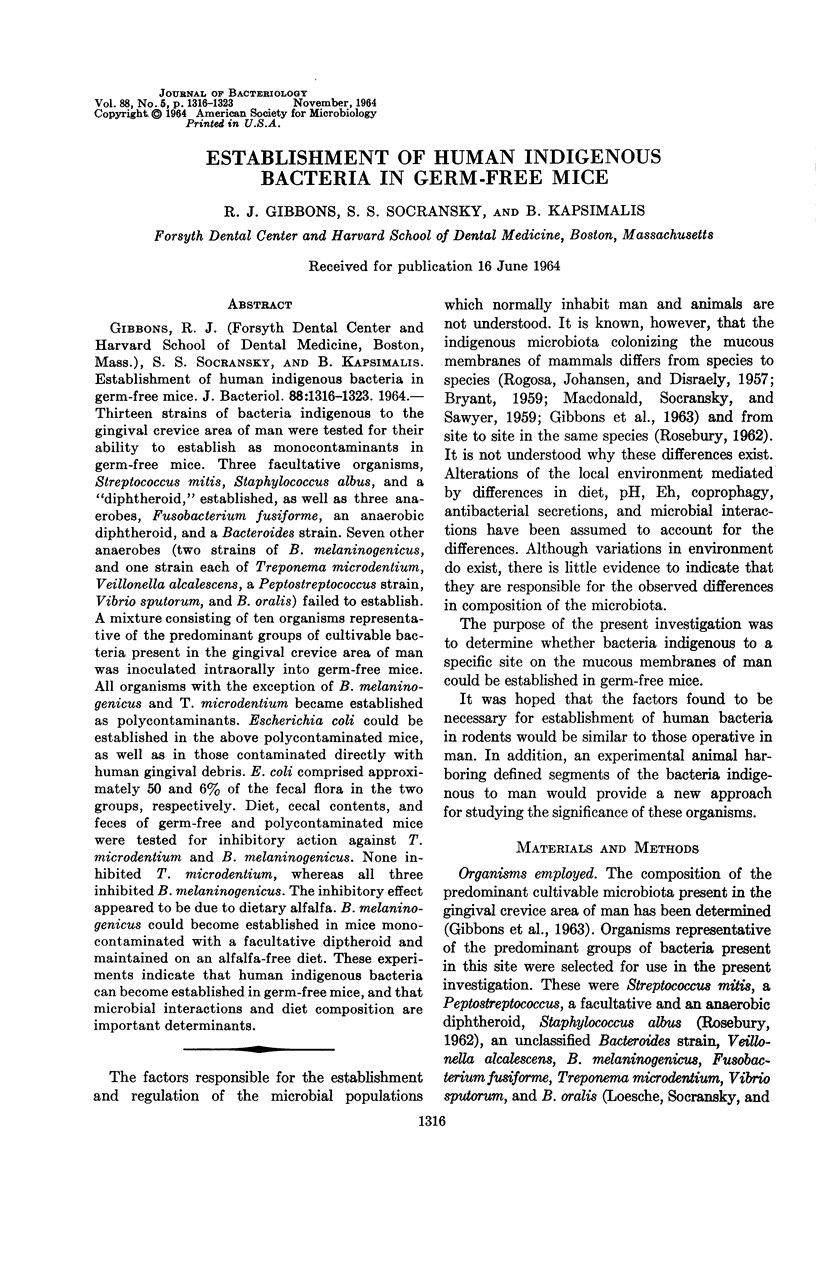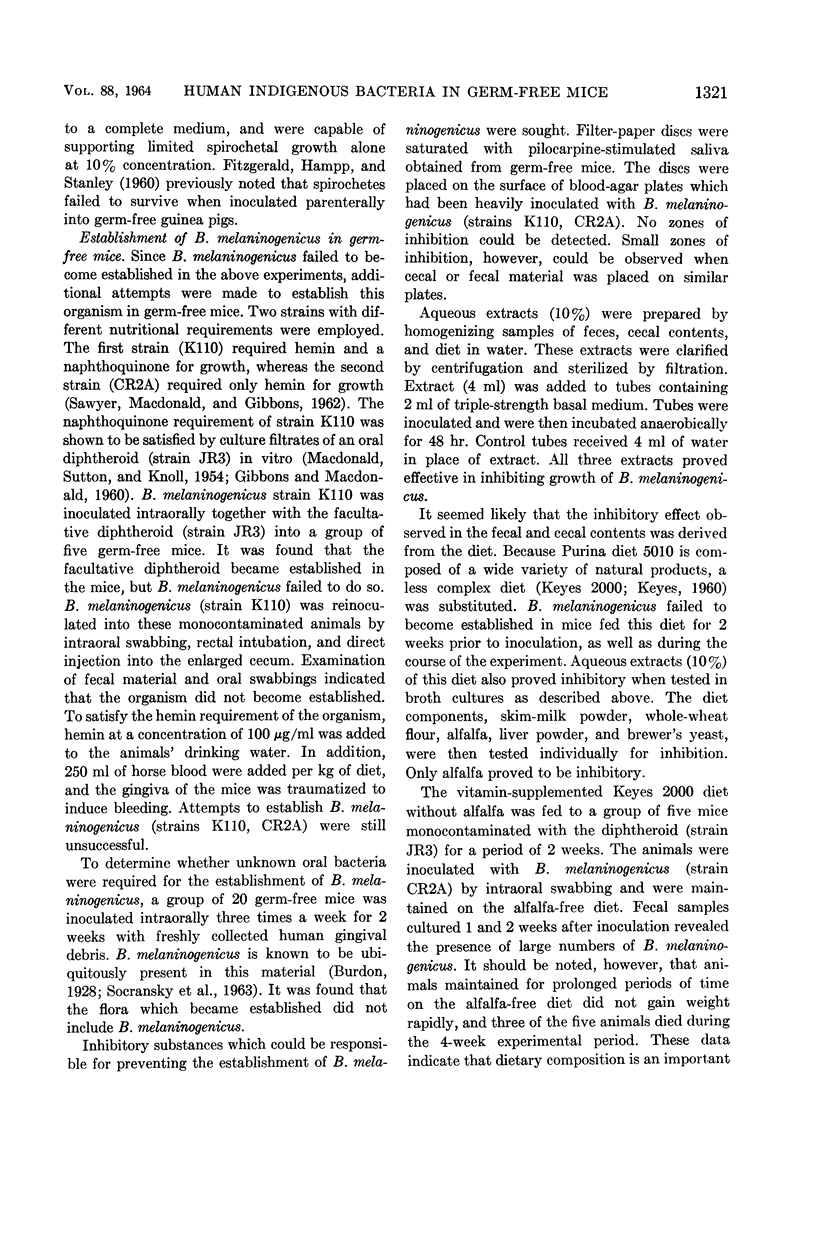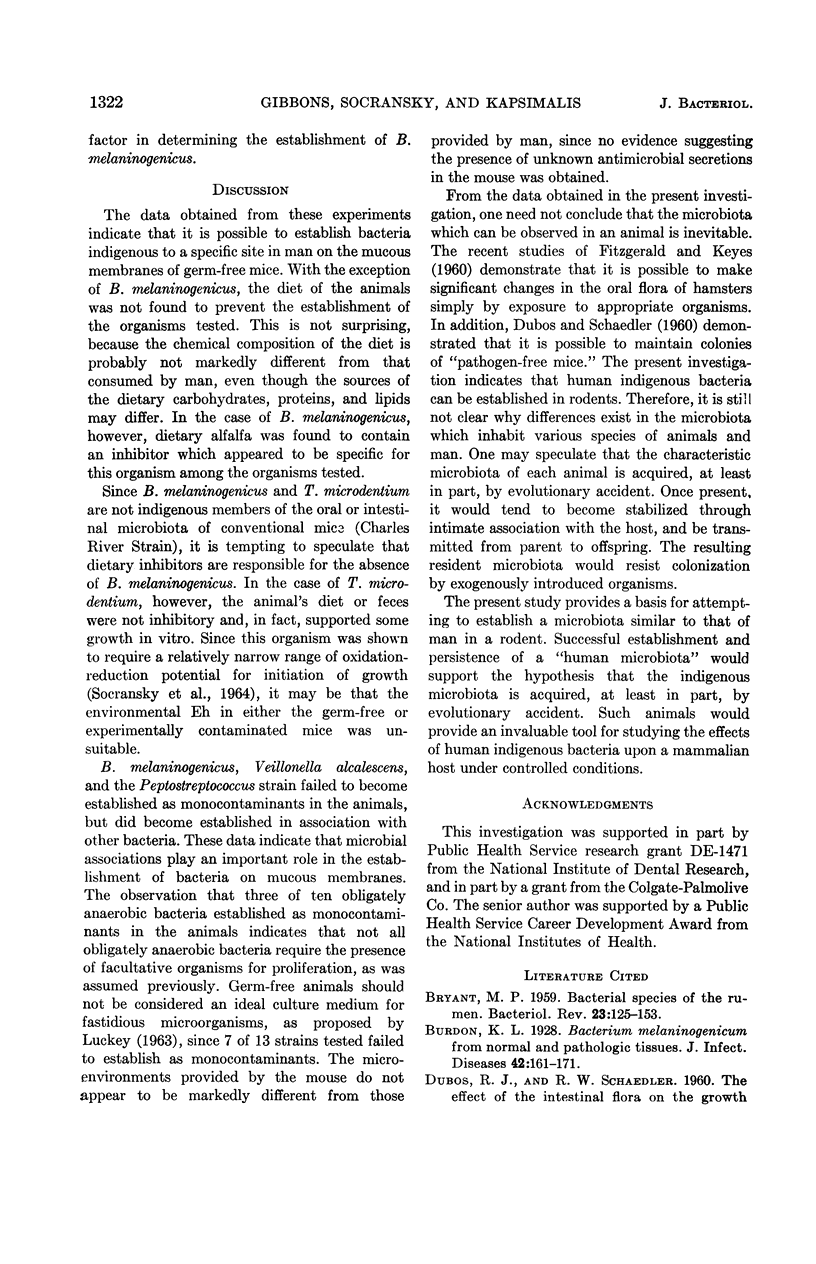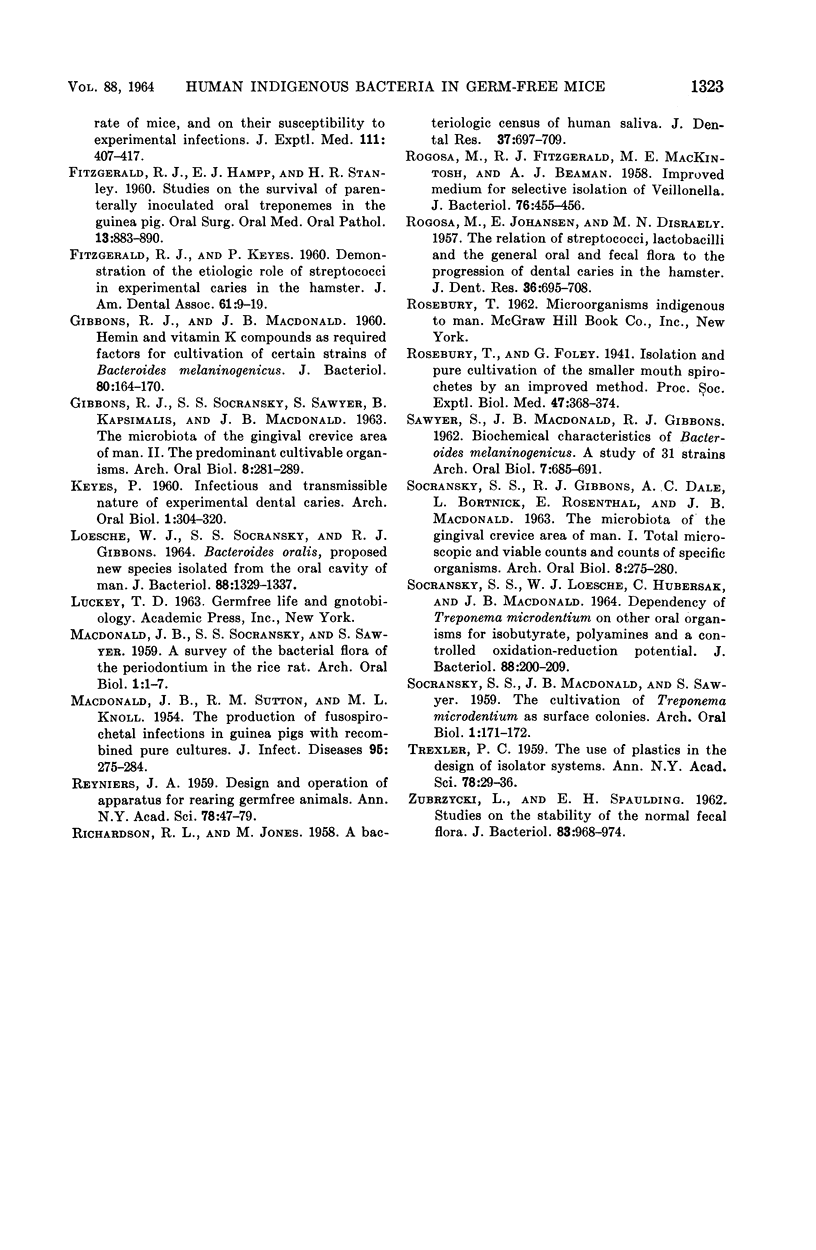Abstract
Gibbons, R. J. (Forsyth Dental Center and Harvard School of Dental Medicine, Boston, Mass.), S. S. Socransky, and B. Kapsimalis. Establishment of human indigenous bacteria in germ-free mice. J. Bacteriol. 88:1316–1323. 1964.—Thirteen strains of bacteria indigenous to the gingival crevice area of man were tested for their ability to establish as monocontaminants in germ-free mice. Three facultative organisms, Streptococcus mitis, Staphylococcus albus, and a “diphtheroid,” established, as well as three anaerobes. Fusobacterium fusiforme, an anaerobic diphtheroid, and a Bacteroides strain. Seven other anaerobes (two strains of B. melaninogenicus, and one strain each of Treponema microdentium, Veillonella alcalescens, a Peptostreptococcus strain, Vibrio sputorum, and B. oralis) failed to establish. A mixture consisting of ten organisms representative of the predominant groups of cultivable bacteria present in the gingival crevice area of man was inoculated intraorally into germ-free mice. All organisms with the exception of B. melaninogenicus and T. microdentium became established as polycontaminants. Escherichia coli could be established in the above polycontaminated mice, as well as in those contaminated directly with human gingival debris. E. coli comprised approximately 50 and 6% of the fecal flora in the two groups, respectively. Diet, cecal contents, and feces of germ-free and polycontaminated mice were tested for inhibitory action against T. microdentium and B. melaninogenicus. None inhibited T. microdentium, whereas all three inhibited B. melaninogenicus. The inhibitory effect appeared to be due to dietary alfalfa. B. melaninogenicus could become established in mice monocontaminated with a facultative diptheroid and maintained on an alfalfa-free diet. These experiments indicate that human indigenous bacteria can become established in germ-free mice, and that microbial interactions and diet composition are important determinants.
Full text
PDF







Selected References
These references are in PubMed. This may not be the complete list of references from this article.
- BRYANT M. P. Bacterial species of the rumen. Bacteriol Rev. 1959 Sep;23(3):125–153. doi: 10.1128/br.23.3.125-153.1959. [DOI] [PMC free article] [PubMed] [Google Scholar]
- FITZGERALD R. J., HAMPP E. G., STANLEY H. R. Studies on the survival of parenterally inoculated oral treponemes in the guinea pig. Oral Surg Oral Med Oral Pathol. 1960 Jul;13:883–890. doi: 10.1016/0030-4220(60)90020-7. [DOI] [PubMed] [Google Scholar]
- FITZGERALD R. J., KEYES P. H. Demonstration of the etiologic role of streptococci in experimental caries in the hamster. J Am Dent Assoc. 1960 Jul;61:9–19. doi: 10.14219/jada.archive.1960.0138. [DOI] [PubMed] [Google Scholar]
- GIBBONS R. J., MACDONALD J. B. Hemin and vitamin K compounds as required factors for the cultivation of certain strains of Bacteroides melaninogenicus. J Bacteriol. 1960 Aug;80:164–170. doi: 10.1128/jb.80.2.164-170.1960. [DOI] [PMC free article] [PubMed] [Google Scholar]
- GIBBONS R. J., SOCRANSKY S. S., SAWYER S., KAPSIMALIS B., MACDONALD J. B. The microbiota of the gingival crevice area of man. II. The predominant cultivable organisms. Arch Oral Biol. 1963 May-Jun;8:281–289. doi: 10.1016/0003-9969(63)90020-7. [DOI] [PubMed] [Google Scholar]
- KEYES P. H. The infectious and transmissible nature of experimental dental caries. Findings and implications. Arch Oral Biol. 1960 Mar;1:304–320. doi: 10.1016/0003-9969(60)90091-1. [DOI] [PubMed] [Google Scholar]
- LOESCHE W. J., SOCRANSKY S. S., GIBBONS R. J. BACTEROIDES ORALIS, PROPOSED NEW SPECIES ISOLATED FROM THE ORAL CAVITY OF MAN. J Bacteriol. 1964 Nov;88:1329–1337. doi: 10.1128/jb.88.5.1329-1337.1964. [DOI] [PMC free article] [PubMed] [Google Scholar]
- MACDONALD J. B., SUTTON R. M., KNOLL M. L. The production of fusospirochetal infections in guinea pigs with recombined pure cultures. J Infect Dis. 1954 Nov-Dec;95(3):275–284. doi: 10.1093/infdis/95.3.275. [DOI] [PubMed] [Google Scholar]
- RICHARDSON R. L., JONES M. A bacteriologic census of human saliva. J Dent Res. 1958 Aug;37(4):697–709. doi: 10.1177/00220345580370041701. [DOI] [PubMed] [Google Scholar]
- ROGOSA M., FITZGERALD R. J., MACKINTOSH M. E., BEAMAN A. J. Improved medium for selective isolation of Veillonella. J Bacteriol. 1958 Oct;76(4):455–456. doi: 10.1128/jb.76.4.455-456.1958. [DOI] [PMC free article] [PubMed] [Google Scholar]
- ROGOSA M., JOHANSEN E., DISRAELY M. N. The relation of streptococci, lactobacilli, and the general oral and fecal flora to the progression of dental caries in the hamster. J Dent Res. 1957 Oct;36(5):695–708. doi: 10.1177/00220345570360050901. [DOI] [PubMed] [Google Scholar]
- SAWYER S. J., MACDONALD J. B., GIBBONS R. J. Biochemical characteristics of Bacteroides melaninogenicus. A study of thirty-one strains. Arch Oral Biol. 1962 Nov-Dec;7:685–691. doi: 10.1016/0003-9969(62)90117-6. [DOI] [PubMed] [Google Scholar]
- SOCRANSKY S. S., GIBBONS R. J., DALE A. C., BORTNICK L., ROSENTHAL E., MACDONALD J. B. The microbiota of the gingival crevice area of man. I. Total microscopic and viable counts and counts of specific organisms. Arch Oral Biol. 1963 May-Jun;8:275–280. doi: 10.1016/0003-9969(63)90019-0. [DOI] [PubMed] [Google Scholar]
- SOCRANSKY S. S., LOESCHE W. J., HUBERSAK C., MACDONALD J. B. DEPENDENCY OF TREPONEMA MICRODENTIUM ON OTHER ORAL ORGANISMS FOR ISOBUTYRATE, POLYAMINES, AND A CONTROLLED OXIDATION-REDUCTION POTENTIAL. J Bacteriol. 1964 Jul;88:200–209. doi: 10.1128/jb.88.1.200-209.1964. [DOI] [PMC free article] [PubMed] [Google Scholar]
- SOCRANSKY S., MACDONALD J. B., SAWYER S. The cultivation of Treponema microdentium as surface colonies. Arch Oral Biol. 1959 Oct;1:171–172. doi: 10.1016/0003-9969(59)90009-3. [DOI] [PubMed] [Google Scholar]
- TREXLER P. C. The use of plastics in the design of isolator systems. Ann N Y Acad Sci. 1959 May 8;78:29–36. doi: 10.1111/j.1749-6632.1959.tb53093.x. [DOI] [PubMed] [Google Scholar]
- Zubrzycki L., Spaulding E. H. STUDIES ON THE STABILITY OF THE NORMAL HUMAN FECAL FLORA. J Bacteriol. 1962 May;83(5):968–974. doi: 10.1128/jb.83.5.968-974.1962. [DOI] [PMC free article] [PubMed] [Google Scholar]


